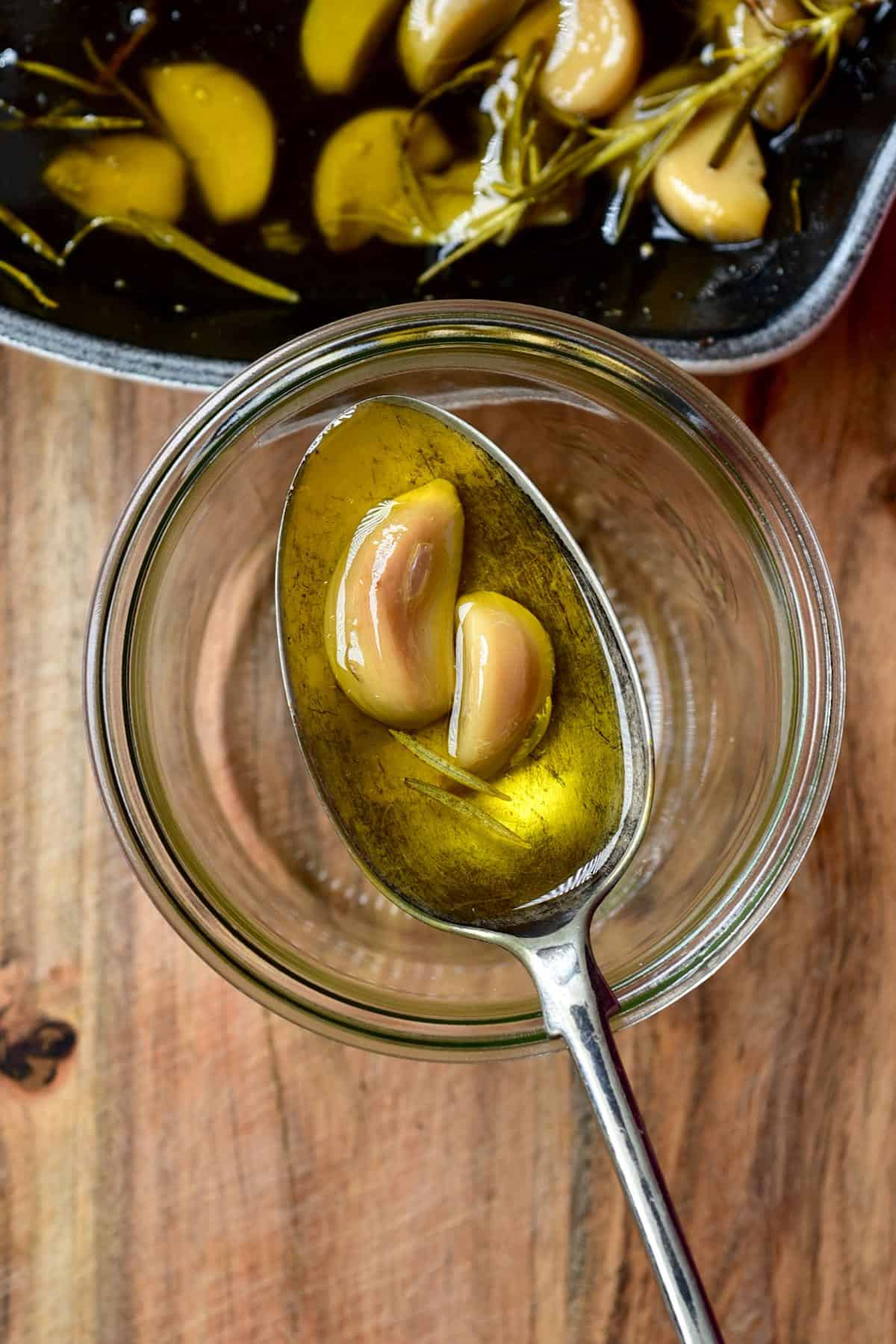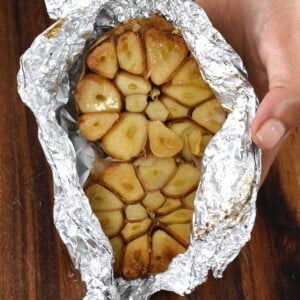This post may contain affiliate links. Please read our disclosure policy.
Learn how to make garlic confit at home with one of my three methods, top tips, and a video tutorial. The slowly cooked cloves will become soft and tender, with a mellow, rich taste, and are a great addition to any meal.

I’m a big fan of garlic and love experimenting with recipes where it takes center stage. Whether it’s oven-roasted garlic adding depth to dishes, the creamy kick of Lebanese garlic sauce, or the sweet heat of fermented garlic honey, these staples are always in my kitchen. That’s how much I love this versatile ingredient!
So, it should be no surprise that I am sharing how to make garlic confit—it is another of my favorites. I am even sharing three methods so you can choose the one that best fits your needs – on the stovetop (taking less than 30 minutes!), in the oven, and in a crockpot.
The garlic cloves become tender, soft, and smooth like butter, and their flavor is milder and slightly sweet. I love to add the garlic confit to so many dishes or even just spread it on some toasted bread. For anyone who’s even slightly a fan of garlic, I’m sure you will love this garlic confit recipe just as much as I do.
Want to save this recipe?
Watch the garlic confit video
What is garlic confit?
Confit (pronounced “kon-FEE”) is a French cooking method for preserving food (like this tomato confit recipe). Garlic confit is made by cooking garlic in generous amounts of fat (in this case, extra virgin olive oil) at low heat until tender and lightly browned.
Once ready, the garlic cloves become soft, sweet, rich, and flavorful without the bitterness of raw garlic. Best of all, this method yields TWO delicious products: tender, buttery garlic, AND fragrant garlicky oil.

Ingredients

- Garlic: Use as much or as little as you want. Fresh, firm bulbs will have the best flavor, though pre-peeled garlic cloves will also work.
- Extra virgin olive oil: It is the best option because of its flavor, but other cooking oils, such as vegetable oil, grape seed oil, canola oil, and avocado oil, will work, too, even if they slightly affect the flavor. You will need enough oil to cover the cloves in your pan.
- Herbs: (optional) I used rosemary. However, you can experiment with others, such as oregano, chili flakes, thyme, peppercorns, fennel, bay leaves, etc.
See the recipe card for full information on ingredients and quantities.
How to make garlic confit
Prepare the garlic: If you don’t have peeled garlic, you can use one of these easy methods to peel garlic. Once peeled, you can also optionally remove the stem end of the cloves.

On the stovetop
Place the rosemary and garlic cloves in a medium-sized saucepan. Then, cover them with enough oil to submerge the garlic fully.
Heat on low heat and cook for about 20-30 minutes. Keep an eye on them and stir occasionally. If the oil is bubbling too much or it seems like the cloves are starting to burn at the bottom, lower the heat even more.
Within 20-30 minutes, the cloves will become soft like butter. You can remove the pot from the heat whenever you are happy with garlic confit softness and creaminess—test by taking one and spreading it over a cracker or toasted bread.

In the oven
Preheat the oven to 210ºF/100ºC. It’s best to use a smaller dish with high sides, like a deep baking tray, casserole dish, or an oven-proof skillet.
Add the ingredients to the dish. I like to place the rosemary first, then the garlic cloves, and finally, pour the olive oil over them. Make sure you add enough oil to submerge the garlic entirely so the cloves don’t burn.
Place the dish in the oven and slow-cook the garlic at 210ºF/100ºC for about 2 hours. I recommend checking at 1:30 hours and then every 10-15 minutes, as each oven is different.
When ready, the confit garlic cloves will be tender and lightly golden but not too browned. Test their softness by spreading one on some toast or a cracker.

If using a cast iron skillet/pan, the garlic might take 10-15 minutes longer to cook as the pan takes longer to heat.
In the crockpot
Place the garlic cloves and rosemary in the slow cooker, and then pour the oil over them, making sure all the cloves are submerged. Close the lid of the crockpot, and then select the LOW temperature setting.
Let the garlic and oil slow-cook for 2 hours, and then test the softness of the cloves. If you want them more browed and more tender, increase the time and check on them every 10 minutes or so. Keep in mind that even if you turn off the crockpot, if you leave the confit inside, it will continue to cook as the machine is hot.
That’s why, as soon as you are happy with the creaminess, I recommend carefully transferring the garlic confit (cloves and oil) to another heat-proof dish where it can cool.

Cool the garlic confit and store
Once ready, allow the garlic confit to cool to room temperature. To speed up the cooldown time, place the confit in a sterilized glass jar and place the jar in an ice bath (a bowl with ice-cold water). Optionally, you can remove the herbs. Finally, place the jar in the refrigerator as soon as it cools enough.

Recipe tips and notes
- To peel garlic quickly, break the garlic head into cloves by pressing it lightly with the palm of your hand. Place the cloves in a Tupperware container, a mason jar with a lid, or between two metal bowls, and shake for 20-30 seconds. The cloves may not be fully peeled, but the skins will be loose enough to remove easily. For more methods, check out my post on Check my post for how to peel garlic.
- Opt for high-quality oil.
- Cook slowly over low heat!
- Store the garlic confit in the refrigerator. The oil may solidify in the fridge, but you can easily spoon out the garlic cloves or the oil, and they will quickly come to room temperature.
Ways to use garlic confit
I wouldn’t be exaggerating if I said that I use this garlic confit recipe on everything. Here are my favorite ways to use it:
- Spread over toasted bread or crackers (like these seeded crackers)- alone or with cream cheese and other spreads.
- As part of a cheese board – with veggies, antipasti, and lots of cheese.
- Add it to roasted vegetables or mash the cloves into dishes like creamy mashed potatoes or crispy smashed potatoes.
- Smash it over this Burrata Caprese salad or other salad bowls.
- Flavor pasta dishes and bakes – like this one-pot pasta or pasta with roasted red pepper sauce.
You can also use the cloves or the garlic oil in dips, sauces, spreads, vinaigrettes, dressings (like this roasted garlic dressing), etc. I love to use the oil as a dipping oil for bread or when sauteeing instead of vegetable oil.

More garlic recipes
If you try this garlic confit recipe at home, let me know how it goes in the comments below. I’d appreciate a recipe card rating and would love to see your recipe recreations – tag me on Instagram @Alphafoodie!

Garlic Confit (3 Easy Methods)
Ingredients
- 3 heads garlic or use pre-peeled cloves
- 1.5 cups extra virgin olive oil or neutral vegetable oil (canola, avocado, etc.)
- few sprigs rosemary or any other herb of your choice
This will yield about 3 cups of confit.
Instructions
- Stovetop method: Simmer garlic and rosemary in oil over low heat for 20–30 minutes, stirring occasionally, until garlic is soft and lightly golden.
- Oven method: Bake garlic and rosemary fully submerged in oil at 210ºF (100ºC) for 2 hours, or until soft and spreadable.
- Slow Cooker method: Cook garlic and rosemary in oil on LOW for 2 hours, until tender and creamy.
- Let the confit cool completely, then transfer to a sterilized jar and refrigerate.
Video
Notes
- Keep heat low
- Fully submerge garlic
- Use clean utensils
Nutrition
Nutrition information is automatically calculated, so should only be used as an approximation.













Use coconut oil if you want to freeze,it goes solid
Thanks for the tip!
Thank you so much for all detailed information. I love it!
Glad you liked it, Lina 🙂
Where is the recipe for the one cooked in butter? That’s the one I was looking for. Although, bothe ways are ok I really would like th amount of butter used etc.
Hi Stephanie,
You can use 1 pack of butter (250 g/8.8 oz or even more) with two garlic cloves. Or double it if you want. Let me know how it goes! 🙂
Amazing, just Perfect!
The Rosemary takes it to a whole new level!
Glad you enjoyed it, Lily!
Sehr fein…habe noch Wacholder, Lorbeerblatt und Zitronenschale mit gegart……. ein Träumchen….
Hey Maggy! Thanks for sharing your twist with juniper, bay leaf, and lemon zest. That sounds amazing! Enjoy the garlic confit 🙂
Hi, I made this today just like you instructed. I put it in a baking dish and put it in my air fry on 120 for 20 mins. Came out perfect.
Thank you for your comment, Darleen. So happy you enjoyed the confit!
Can I use dried herbs instead?
Hi Ian,
I recommend using fresh herbs – they will infuse the oil better and won’t burn while cooking. If you don’t want to use rosemary, you can use thyme, bay leaves, parsley, or your favorites.
So do I take the garlic out of the oil when I store it, or do I put all of it in the refrigerator to store and use within 2 weeks?
Hi Sheri,
You leave the garlic in the oil (the garlic is the main ingredient here). Yes, put everything in the fridge and use it within 2 weeks. Please refer to the FAQS section of this recipe for more details. I hope this helps. 🙂
I tried your recipe yesterday. Very tasty.
I used a mini dutch oven, avocado oil, 2 sprigs of thyme, 1 stem of fresh basil, I added a tsp of black peppercorns and 1 tsp of kosher salt. I cooked it on 250degrees f for 2 hours. I had just bought a loaf of fresh sourdough bread. Toasted it and smeared this delicious garlic goodness on. Handed a piece to the son and hubby. Just love that reaction. OMG….mmmmmm! That makes me happy 🙂
My hubby is a huge fan of spaghetti I make using this confit. I just take a spoonful of this confit and add it to a pan making sure you grab some of the oil too. I add fresh lemon zest, fresh lemon juice, a pinch of pepper flakes and shrimp. Toss in your cooked spaghetti and garnish with fresh parsley and parmesan cheese. Easy but yummy. Thanks for sharing your recipe. And…yes, I do keep mine in the refrigerator.
Thank you for the recipe.
Thank you for the lovely feedback, Vicky! that sounds delicious! I’m glad you and your family like it. 🙂
What kind of container did you use to store it?? Thanks
Hi Emma,
I stored it in a sterilized glass jar. Keep it in the fridge.
Incredibly well detailed including safety details.
Congratulations.
Thank you so much, Jaime! 🙂